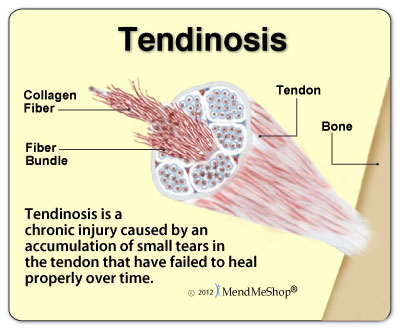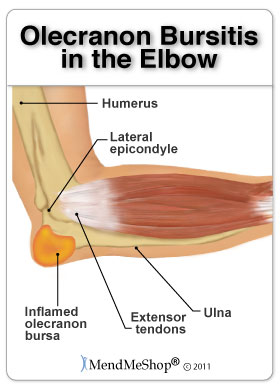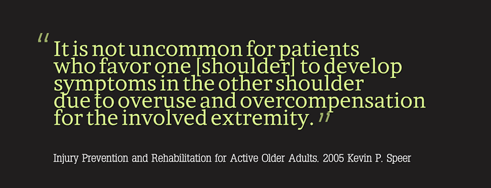Tennis elbow is a form of tendinosis which means chronic degeneration of the tendon or tendons. You will have damage to the tendons that attach to the small bony part on the outside of your elbow (lateral epicondyle), and perhaps a bit of swelling but not much. Tennis Elbow is caused from the overuse of the tendons located in your forearm that help to extend your wrist and fingers; this means tennis elbow can stem from any activity that involves gripping and twisting the forearm and contrary to its name, tennis elbow is typically not related to tennis or any kind of exercise*. The wear and tear on these tendons is a result of small tears in your tissue that don't heal properly. The inability of your tendon to heal properly causes the tendons to weaken until the tissues become very thin, and eventually wear out.
"Arthritis Research UK" The Chartered Society Of Physiotherapy. Accessed April 17 2019. https://www.csp.org.uk/publications/tennis-elbow-exercises.
To learn more about the elbow specifically, please go to our Elbow Anatomy page.
To learn what causes Tennis Elbow, please go to our Tennis Elbow Causes page.
Tendinosis will get worse over time if not dealt with properly. Your body is trying very hard to heal the damaged tissue but if you keep straining your tendons, the damage grows faster than your body can heal it. This cycle of pain, swelling and unhealing causes tennis elbow to go on for a very long period of time (ie. years). Why? Failed healing, not inflammation; if you cannot rest the elbow and wrist while you are healing then your odds of healing it for good are quite low.
Tennis elbow can affect anyone. In 75% of cases, tennis elbow occurs on your dominant arm. It affects about an equal number of men and women, generally between the ages of 35-65 years old. (source: NCBI U.S. National Library of Medicine)
Tendonosis is a noninflammatory, degenerative condition of the collagen fibers in the tendon often caused by repetitive stress injury of the tendon fibers. As the collagen breaks down, the typically straight and flexible fibers become a tangled mess with little pockets of jelly.
Tendonosis is caused by repetitive motion which causes an accumulation of microinjuries. The tendon tries to repair itself but eventually the breakdown of the collagen fibers exceeds the repair speed and the new collagen is produced with an abnormal structure and composition.

Unlike tendonitis, there are no inflammatory cells with a tendonosis injury making it hard to diagnose visually as there are no visible symptoms such as swelling, heat and redness. However, both injuries cause pain, tenderness and stiffness of the joints.
If not treated correctly the tendon will continue to degenerate causing a continually worsening injury.
Visiting your doctor when you have elbow pain is always recommended, as there are many possible issues that can happen within the arm and elbow. Sometimes, one set of symptoms can result in multiple diagnoses. Tennis elbow is sometimes misdiagnosed as bursitis or arthritis as they are often symptomatically similar. Some other conditions that have similar symptoms to tennis elbow are shown below..
The olecranon bursa (just below the skin) susceptibile to trauma or injury during falls on the elbow and to infection from scrapes or cuts on the skin covering the joint.
Repeated excessive pressure and/or friction, such as leaning on a table top at work, may cause this bursa to become inflamed producing excessive swelling and elbow pain in this area.
Subtendinous olecranon bursitis is much less common. This type of elbow bursitis results from excessive friction between the triceps tendon and olecranon. This may result, for example, from repeated flexion-extension of the forearm which occurs during certain assembly line jobs, and is one of many repetitive motion type injuries. The pain is most severe during the flexion of the forearm because of pressure exerted on the inflamed subtendinous olecranon bursa by the triceps tendon.

Elbow bursitis can happen to anyone though it occurs more frequently in:
Elbow bursitis is one of those injuries that can really bring down the quality of your life. Anyone - young or old - can suffer from this injury, and if you're active this condition will keep you from doing the things you love to do. The pain from elbow bursitis will interrupt many of your normal daily tasks and make living life harder than it really needs to be.
The closer the bursa is to the surface of the skin, the more likely the chance of infection from specific bacteria (staphylococcus epidermis or staphylococcus aureus) that are commonly found on the surface of the skin. This bacterial infection is known as septic bursitis. Septic bursitis occurs most commonly in men (85% of all cases occur in men) and you are at a higher risk of contracting this if you:
If the bursitis in your olecranon bursa is septic, it can quickly become life-threatening and you will require antibiotics from your doctor to treat the infection. Warmth and redness in the area are signs of an infection as well as a fever. If you suspect your bursitis is septic, be sure to see a doctor immediately.
To learn more about Elbow Bursitis, go here. (opens in new window)
Some people with diseases such as rheumatoid arthritis, gout or scleroderma may contract bursitis from crystalline deposits in the joints. Although not much is known about how this process happens, it is common knowledge that Uric acid is a normal byproduct of daily metabolism. If you are diagnosed with gout then you are unable to break down this uric acid properly, leading to crystallization of this excess acid which deposits in joints, a painful symptom that can often lead to bursitis.
Golfer's Elbow is signified by pain that is felt on the inside of the elbow, whereas Tennis Elbow pain is felt on the outside of the elbow. The tendons attached to the bone at your elbow are connected to muscles in your forearm, which is why these conditions will typically radiate pain from the elbow down the forearm. These injuries are usually caused by racquet sports, golf and overuse from gardening and repetitive movements of your hand or wrist (ie. using a screwdriver).
To learn more about Golfer's Elbow, go here.
Every time we use our elbow that is experiencing tennis elbow, damaged tendons and muscle tissue move. When significant stress is applied to this damaged tissue, you feel pain - sometimes a LOT of pain, so we try not to move it. So, when doing something we purposefully avoid using the "bad elbow" - ff we can, we use our other joints instead even though it is inconvenient and difficult.
A couple days later the pain recedes in the elbow and forearm, and we start using our elbow normally again. At this point the tennis elbow pain starts up again like it did before - all because the injury wasn't fully healed in the first place. We continually worsen our tennis elbow through our daily activities and thus the downward spiral of tennis elbow continues.
Eventually, we use the other joints more and more. This is why the other joints start to hurt more - they are being overused now. Soon, aches and pain can become commonplace - all as a result of the original tennis elbow and the body's instinctive nature to "protect" the area - all because the injury wasn't fully healed in the first place!

Muscle imbalances result, placing tension on bone and softer tissues - leading to a misalignment in the body. The extra stress on the opposite elbow (and shoulder) will also result in weakness and fatigue of soft tissue - increasing the chances they can eventually be injured or gradually degenerate (ie. muscle strain and/or tendinitis). This is a textbook example of how you get an overcompensation injury.
An injury to one area can easily lead to straining in other areas - just due to the pain response in your biomechanics - making an overall recovery hard to initiate. For example, a serious case of tennis elbow in the right elbow will often lead to over-straining of the left elbow. Most commonly, the injury occurs on the dominant side, so the risk of straining the other (weaker) side increases even further as it is the weaker joint to begin with. The longer the injury (and corresponding pain) persists, the greater the chance that you will sustain more strain from overcompensation, eventually leading to issues in those areas as well. To minimize potential secondary injuries, know that it is important to deal with your injury quickly and completely.
Truly, living with tennis elbow can lead you into a vicious downward cycle - which is why it is absolutely critical to focus on methods that improve and strengthen the damaged extensor tendons in the forearm in a timely manner. The faster you truly heal, the less chance you have of sinking into a downward spiral of re-injury, scar tissue growth and overcompensation injuries.
Product Advisors are available 9:00 am to 5:00 pm Eastern Standard Time Monday to Friday.
I want to learn more about TShellz Wrap® Circulatory Boost
I want to learn more about Ice & Heat: Which Is Better For Treatment?
I want to learn How To Get Rid of Tennis Elbow
I want to learn How To Get Rid of Golfers Elbow
I want to learn more about Elbow Anatomy
I want to learn more about Elbow Surgery
I want to learn more about Elbow Post-Surgery Recovery
During your recovery, you will probably have to modify and/or eliminate any activities that cause pain or discomfort at the location of your soft tissue injury until the pain and inflammation settle. The more diligent you are with your treatment and rehabilitation, the faster you will see successful results!
Please be aware that this information is neither intended nor implied to be a substitute for professional medical advice. CALL YOUR HEALTHCARE PROVIDER IMMEDIATELY IF YOU THINK YOU MAY HAVE A MEDICAL EMERGENCY. Always seek the advice of your physician or other qualified health provider before using any of our outstanding products to make sure they are right for you and your condition or if you have any questions regarding a medical condition. Always see your doctor for a proper diagnosis as there are often many injuries and conditions (some very serious) that could be the cause of your pain.
© 2025 In.Genu Design Group, Inc. Contact Us